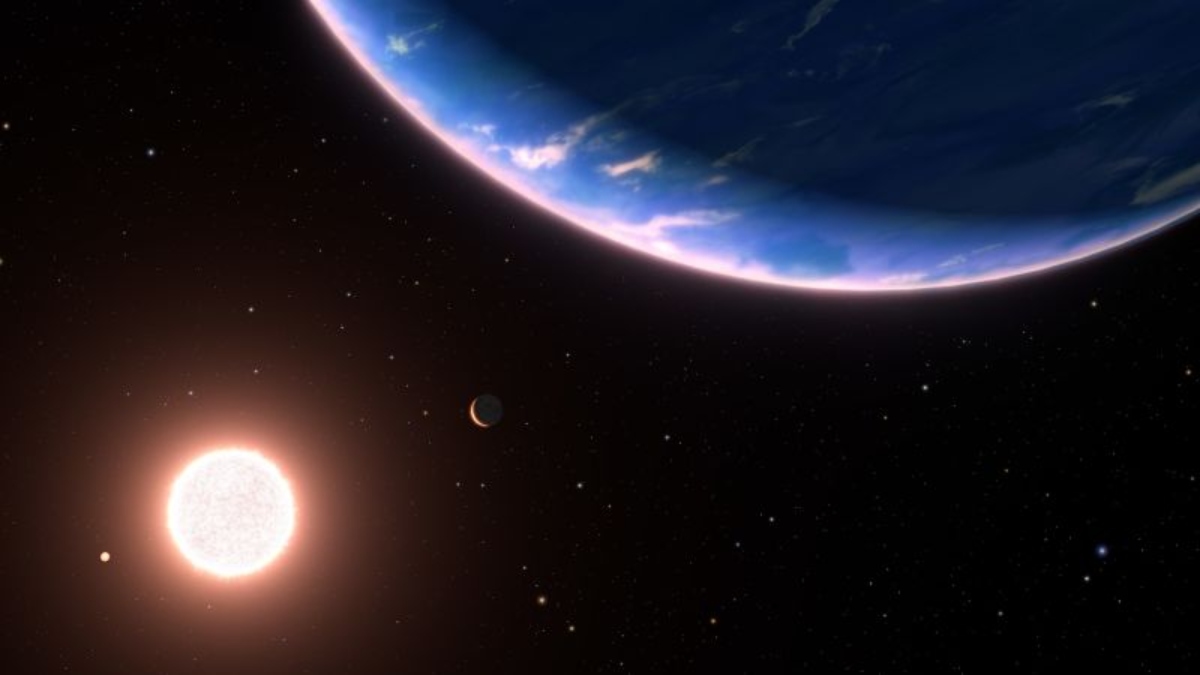(CNN) — Using the Hubble Space Telescope, astronomers have discovered water molecules in the atmosphere of a small exoplanet 97 light-years from Earth.
The planet, called GJ 9827d, is roughly twice the diameter of Earth and is the smallest exoplanet whose atmosphere contains water vapor, according to a new study.
Water is essential for life as we know it, but the planet is unlikely to support any life due to scorching temperatures that turn its water-rich atmosphere into scorching steam.
Astronomers have yet to discover the true nature of this unusual world's atmosphere, but the discovery paves the way for new research as they seek to understand the origins of planets outside our solar system.
The findings appear in a report published Thursday in Astrophysical Journal Letters.
“Water on such a small planet is a historic discovery,” Laura Kreidberg, study co-author and head of the Department of Exoplanetary Atmospheric Physics at the Max Planck Institute for Astronomy in Heidelberg, Germany, said in a statement. “It's getting closer than ever to characterizing worlds that are truly Earth-like.”
However, the planet's temperature reaches 800°F (427°C), making it a steamy and inhospitable world, as hot as Venus.
“This will be the first time we have directly demonstrated through atmospheric detection that these planets with water-rich atmospheres can actually exist around other stars,” said study co-author Björn Beneke, a professor at the university's Trottier Institute for Exoplanet Research. New York and the University of Montreal in a statement. “This is an important step in determining the prevalence and diversity of atmospheres on rocky planets.”
Currently, the research team cannot determine whether Hubble detected traces of water vapor within a puffy, hydrogen-rich atmosphere or whether the planet has a water-rich atmosphere because the host star vaporized GJ 9827d's original hydrogen-helium atmosphere.
“Our observing program, led by principal investigator Ian Crosfield of the University of Kansas (Lawrence, Kansas), was specifically designed to not only detect molecules in the planet’s atmosphere, but also look for water vapor.” “Either outcome would be exciting, whether water vapor is dominant or just a small species in a hydrogen-dominated atmosphere,” Alexis Roy, lead author of the study and a doctoral student at the Trottier Institute at the University of Montreal, said in a statement.
Planetary puzzle
NASA's Kepler mission initially discovered the planet when it orbited a red dwarf star in the constellation Pisces in 2017. The exoplanet completes one orbit around its host star every 6.2 days.
Astronomers observed planet GJ 9827d during 11 transits, or the times the planet crossed in front of its star during orbit, over a period of three years. Starlight filtered through the planet's atmosphere helped astronomers measure the signature of water molecules.
“Until now we have not been able to directly detect the atmosphere of such a small planet. Now we are slowly entering this system,” Beneke said. “At some point, as we study small planets, there must be a transition where these small worlds no longer have hydrogen, and they have atmospheres more like that of Venus (where carbon dioxide dominates).”
Knowing more about the planet's atmosphere could help astronomers classify exactly what type of world GJ 9827d is. Currently, the team has two possible theories.
It is possible that the planet is a small Neptune, with an atmosphere rich in hydrogen and containing water vapor. If so, GJ 9827d likely formed at a greater distance from its host star than its current location, meaning the planet would have been cooler and water would have been present in the form of ice (similar to Neptune and Uranus, the farther away planets from Earth). our solar system).
According to the researchers, when a planet approaches its star and receives more stellar radiation, the hydrogen heats up and escapes, or continues to escape.
Or astronomers suspect that GJ 9827d could be a hotter version of Jupiter's icy moon Europa, which has an ocean beneath a thick icy crust. Beneke said the planet could be half water and half rock.
Searching for water in space
Water is one of the most common molecules found in the universe, and astronomers have for years included the discovery of water as an important part of the search for extraterrestrial life.
“Water monitoring is looking through a portal to find other things,” Thomas Green, co-author of the study and an astrophysicist at NASA's Ames Research Center in California's Silicon Valley, said in a statement. “This Hubble discovery opens the door to future studies of such planets with the James Webb Space Telescope. With additional infrared observations, the James Webb Space Telescope can see much more, including carbon-bearing molecules such as carbon monoxide, carbon dioxide and methane.” “A complete inventory of the planet's elements, so we can compare them to the elements of the star it orbits and understand how it formed.”
Astronomers have already observed GJ 9827d using the Webb telescope to look for water and other types of molecules, and that data will be shared in the future.
“We're excited to see what this data reveals,” says Kreidberg. “We hope that we can now solve the problem of water worlds once and for all.”

“Proud web fanatic. Subtly charming twitter geek. Reader. Internet trailblazer. Music buff.”


:quality(85)/cloudfront-us-east-1.images.arcpublishing.com/infobae/7TXNTX4Z6ZADNGBBYTUT45QETM.jpg)
:quality(85)/cloudfront-us-east-1.images.arcpublishing.com/infobae/TR43PX4FQRCGJOYTK6DVVHHXGE.jpg)


More Stories
NASA finds rock on Mars that may contain ancient microscopic life
Astronauts stranded in space due to Boeing spacecraft malfunction won’t be able to return home for weeks
Download YoWhatsApp Plus 2024 Latest Updated APK for Android | WhatsApp Plus APK